Progress report for FNE24-081
Project Information
Ley rotations have been shown to provide a diversity of ecosystem service benefits, including regulatory(such as climate and flood regulation), cultural (such as food security, farming communities, and recreation), and supportive (such as soil health, nutrient cycling, and biodiversity). However, the degree and types of services may vary depending on the management of the ley rotation system. Additionally, some aspects, such as the impact of livestock grazing or the impacts of the ley system on the soil microbiome, require further study.
Our objective is to clarify the soil and forage impacts of a no-input ley system with a 5- to 6-year pasture phase, incorporating rotational livestock grazing, and a 2- to 3-year mixed cereal and vegetable rotation. This type of pasture-dominant ley system with diverse cereal and vegetable
rotations holds potential for increasing the full suite of ecosystem service benefits for small to midsize meat and dairy farmers in the Northeast.
By incorporating laboratory tests of soil health, soil microbiology, and forage quality at all phases of the ley rotation, this study will investigate and
document that this system produces not only the soil health benefits observed by other peer studies on various ley systems, but also forage benefits (or at least neutral forage impacts) for the adopting livestock farmer. Additionally this study will begin to fill the gaps in our understanding of diverse, grazed, multi-species leys integrated with both cereal and vegetable production, particularly the impacts on soil microbial communities.
Our objective is to clarify the soil and forage impacts of a no-input ley system with a 5- to 6-year pasture phase, incorporating livestock grazing, and a 2- to 3-year mixed grain and vegetable rotation. Specifically, we will determine if this type of system will impact soil carbon sequestration. We will also look for other soil health effects, particularly changes in aggregate stability, bulk density, nitrogen, phosphorus, and other macro-minerals. Additionally, we will study the impacts on the soil microbiome. Does the physical disturbance of the ley or the selection of crop species have an
impact on the taxon diversity and functional biodiversity of the soil microbiome?
We further will test if these ley rotations can improve the nutrition of the resulting pasture-phase forage. We will test potential effects on energy
content and crude protein, as well as various macro- and micro-minerals.
Our hope is that this type of system can be expanded to small livestock and dairy farmers in the Northeast, to provide benefits to the farmer in both economic diversification and soil and forage quality outcomes. But first, we must better quantify the effects this type of ley has on the ecology and productivity of our regional system.
Modern agriculture, particularly in the United States, has seen an overwhelming shift toward intensification and specialization, i.e., monocultural, annual-heavy, continuous cropping systems that rely heavily on costly and environmentally detrimental fertilizers, pesticides, and tillage. These systems prioritize short-term yields in food and fiber productivity at the expense of longer-term benefits in regulating services (such as climate and flood regulation), cultural services (such as food security, farming communities, and recreation), and supporting services (such as soil health, nutrient cycling, and biodiversity).[1] Despite the critical ecosystem services provided by healthy soils; including stable carbon sequestration, nutrient cycling, water storage and purification, and climate regulation, the intensified agricultural practices noted above continue to accelerate the rate of degradation of soil organic carbon (SOC), with agricultural food production contributing as much as 24% of global anthropogenic greenhouse gas emissions.[2] Within this context, there has been increasing interest and research into regenerative agricultural practices, often incorporating a return to older, more diversified systems, as a key solution to these challenges.
One such example of regenerative practices that has seen increased interest is the reintroduction of leys, or fully integrated crop-livestock systems (ICLS), also known as mixed farming systems, for climate resiliency, sustainability, and increased economic viability.[3,4] Research on these practices to date has shown promise in addressing the deficiencies in regulating, cultural, and supporting ecological services, but additional research is needed.[5]
Despite some excellent data from long-term ley experiments in northern Europe,[6-8] much work remains to be done to fully understand the myriad ecological and production impacts of different ley strategies. Cooledge et al.[5] noted the greater need to: 1) test all phases of the ley rotation; 2) better study microbial community composition, biomass, and diversity in multispecies leys under field conditions; 3) study the influence of grazed leys incorporated into arable rotations on soil structure and key measures of biological soil quality; and 4) study crop yields after livestock-grazed leys are returned to arable rotations. Much of the current literature on ley rotations either focuses on: shorter-term leys in predominantly arable cropping systems; systems without grazing impact; grazing systems where the rotations all contribute to livestock forage or feed, rather than vegetable and cereal food production; and/or systems that still amend soil with synthetic fertilizers, manure, or compost.
Over the last fifteen years, SBC has conducted informal experiments to develop and refine a 7- to 8-year, pasture-dominant, livestock-grazed, no-input, rain-fed, multi-species ley rotation system. Ley plots within this system rotate between a 5- to 6-year mixed grass and forb ley phase incorporating at least 10 species of seeded grasses, forbs, and legumes, and a 2- to 3-year grain and vegetable phase that incorporates cover crops and additional grazing (see “Materials and Methods'' for details). This system has great potential for incorporation by small to mid-size, Northeast meat and dairy farmers, either through single-farm diversification or partnerships with nearby crops operations, to provide greater economic resiliency, improved production outcomes, and improved ecological services. However, before we expand to a large study with partner farms (and other interested parties) and thoroughly explore the economic challenges and impacts of adopting this system, we must conduct formal research to better quantify the basic production and ecological services implications of this particular type of ley system at our existing scale.
By incorporating tests of soil structure and health, soil microbiology, and forage quality at all phases of the ley rotation, this study will investigate and document that this ley system produces not only the soil health benefits observed by other peer studies on various ley systems, but also forage benefits (or at least neutral forage impacts) for the adopting livestock farmer. Additionally this study will begin to fill the gaps in our understanding of diverse, grazed, multi-species leys integrated with both cereal and vegetable production, particularly the impacts on soil microbial communities. If this study is successful, we will seek future funding and use this data to recruit partner farms for a larger scale, multi-farm study that will incorporate detailed economic and greenhouse gas life cycle analyses.
Cooperators
- - Technical Advisor
Research
Ley Management and Treatment Groups
While we will not manipulate the basic management of the leys as part of this experiment, the no-input rain-fed ley system we have developed over 15 years of experimentation plays a crucial role in this study by providing the successful model to test. Additionally, because the rotation is on-going, it will provide leys, cereal blocks, and vegetable blocks at all stages of the system so that we can determine the effects of different aspects of the rotation during the short two-year study period.
While there is some variation in grain and vegetable species and variety selection and the timing of grazing events, each ley plot within our system follows the same basic management cycle. Leys are opened from pasture in July, cultivated and seeded to mustards. The mustards receive a hard graze from one of our livestock groups in September, then the plots are cultivated and seeded to winter grains. Clover is then frost-seeded under the grains in late February/early March the next year. Grains are harvested in July, leaving the clover understory, which may or may not be grazed. Here leys may diverge based on location:
- Some leys are cultivated in October and planted half in garlic, followed by buckwheat, with the other half planted in potatoes in April. These leys are then seeded to winter rye in October after the harvests. The rye is cut in May and the plot is seeded to summer annuals for grazing. The plot is then cultivated and seeded back to pasture (Albert Lea Super Grazing Mix; ten planted species including two legumes) in September.
- Other leys, after grain harvest, are cultivated in May and seeded to corn, beans, and sunflowers. Then the fields are seeded to winter cover crop grains in October. Grains are cut in May and the plot is seeded to summer annuals for grazing. Finally those plots are cultivated and seeded back to pasture (Albert Lea Super Grazing Mix) in September.
Specific variations in each ley will be carefully documented and reported, but for the purposes of this study, it is important that each ley will go through a primary grain phase and a primary vegetable phase. No ley that doesn’t meet these minimum requirements will be included in the study.
Treatment Groups
Due to the inability to follow an individual ley through a full cycle in a two-year study, we will be using the variety of leys in different stages of the rotation across our landscape to study the impacts of each phase of the ley rotation. Thus our different treatment groups in the study will be: Fully Mature Pre-Ley Pasture (n = 5), Post-grain Rotation (n = 5), Post-vegetable Rotation (n = 3), 1st Year Post-Ley Pasture (n = 1), 2nd Year Pasture (n = 3), 3rd Year Pasture (n = 4), 4th Year Pasture (n = 3), and 5th Year Pasture (n = 2). Additionally, we will be able to compare this data to control data collected using identical procedures from our perennial cool season pasture plots without leys (n = 13).
Soil Sampling
Soil Health Analysis
Soil health sampling will generally be conducted in August, with the exception of soil samples taken at the end of the pasture phase in June before the ley is opened. We will collect soil samples using the spade method. Fifteen randomly distributed subsamples will be taken from within each ley, thoroughly mixed, and then a composite soil sample of approximately 2000 cm3 will be taken from the mix to be sent for analysis. Soil samples will be refrigerated until ready for overnight shipment.
We will send soil samples for testing at Woods End Laboratories LLC (Augusta, ME). Samples will receive the following key analyses: Total-C, LOI Organic Matter,C:N ratio, Aggregate Stability, Bulk Density, Nitrate, Extractable-P, K, Ca, Mg, Na, pH, Al, Swiss-P, Cu, Mn, Zn, B, and Mo.
Soil Microbiome Analysis
We will use 250mg of the fresh soil from the composite soil health sample, on the day of collection, to extract nucleic acids for microbiome barcoding analysis. DNA/RNA extraction will be performed in our on-site laboratory using the Qiagen DNeasy PowerSoil Pro Kit reagents and protocol. The bead beating step of the extraction will be performed with a BeadBug™ 3 Position Bead Microtube homogenizer. After extraction, samples will be stored in a -80C freezer until they are ready to be shipped for analysis.
PCR amplification and full-length amplicon sequencing (Pac Bio Sequel II) of the extracted DNA will be performed by Integrated Microbiome Resource (Dalhousie University, Halifax, NS, CA). We will be using the 16S, 18S, and ITS primers for ribosomal RNA. The 16s gene/primer is a common primer for soil bacteria barcoding, while ITS is a useful gene/primer for fungal barcoding, and 18s will give us additional fungal taxa, as well as other Eukarya such as soil nematodes.
The testing by Integrated Microbiome Resource will also include a basic bioinformatic analysis package. This will provide: Amplicon Sequence Variant (ASV) analysis, phylogenetic trees, taxon level assignments, measures of alpha and beta microbial diversity, and an analysis of functional diversity using the PICRUSt2.0 algorithm for each sample. Additionally, we will look closely at the fungal to bacterial ratios for each sample.
Forage Sampling and Analysis
Forage sampling will generally be conducted in May during peak growth of cool season grasses. The one exception will be first year pasture post-ley, which will be sampled in September to give ample time for germination and growth.
Vegetation will be clipped with pruning shears from 15 randomly selected locations within each ley. Approximately 250 cm3 of material will be collected at each location from a variety of vegetation levels including canopy and understory. The composite sample should fill a gallon zip-lock bag. Samples will be immediately transferred to a -23C freezer post-sampling for storage until shipping for analysis.
Testing will be done by the Dairy One Forage Laboratory (Ithaca, NY) using their “Basic Plus Minerals” wet chemistry analysis. This analysis will include: dry matter, TDN, crude protein, fiber, Ca, P, Mg, K, Na, Fe, Zn, Cu, Mn, Mo.
Statistical Analysis
In addition to summary statistics for all treatment groups and tests, we will use Principal Components Analysis (PCA) to look for clustering and separation of the various treatment groups in multivariate space in relation to suites of variables (soil health parameters or forage quality parameters). For example, we suspect that when a ley rotation is seeded back to pasture, there is a successional effect as the pasture grasses re-establish themselves, so a pasture may take a few years to mature. If this is true, we might see a clustering of pastures past a certain age compared to younger pastures based on multiple forage quality variables, and this might help us better understand patterns in the data. It is also likely that we will use MANOVAs to test for significant differences between the ley pastures and control perennial pastures in their soil health, soil microbiology, and forage quality characteristics. We will use post hoc tests to further explore any significant results.
Education & outreach activities and participation summary
Participation summary:
We held a half-day field day and tour for Blue Hill at Stone Barns’ front-of-house apprenticeship program participants around the ley rotation project. Participants learned about the ley rotation system and the research project, then participated in soil sampling and observed the laboratory DNA extraction.
Additionally, we toured the Director of Research at the Greenacres Foundation and Farm through one of our ley pastures and described the program in the hopes of spurring future collaborative efforts around the project between the two organizations.
Finally we presented an educational program on the ley rotation project to our restaurant partner chef team and Stone Barns Center members, followed by a field tour of one of the ley pastures.
Learning Outcomes
-Forage nutrition outcomes
-Soil carbon change outcomes
-Increased understanding of how to properly run a ley system and its benefits
Project Outcomes
Despite being in only the first year of the project and consequently having small sample sizes, particularly for forage testing, we are seeing promising initial results. This should provide crucial data to show Northeast dairy and livestock farmers that they can diversify their production and markets through adopting a pasture-focused ley system, while providing increased animal production value and improved ecological services, without the use of additional inputs.
Soil Carbon
Based on our first year of data, there was not a large difference between ley rotation plots (at any stage of the rotation) and our perennial pastures in soil carbon percentage in the top 30cm (see Figure 2). In fact, the average soil carbon percentage for ley rotation plots (3.15) was higher than that of our perennial pastures (2.65).
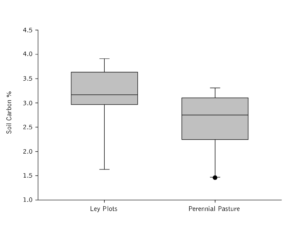
Due to historic practices, some ley pastures may have started with a higher soil carbon content than some of our perennial pastures: however, it seems apparent that our system is not leading to a massive loss of soil organic carbon.
This suggests so far that the soil cultivation inherent in our ley system, in combination with cover cropping and animal impact, is not leading to a loss of soil carbon and may even be leading to an increase in surface soil carbon sequestration.
The possibility of an increase in soil carbon from our ley rotation system is further supported by preliminary data from the four ley plots where we had soil data taken before the ley was opened (Year 1) and then soil data after part or all of the grain/vegetable rotation (see Figure 3). The plot marked with an open triangle had gone through the entire grain/vegetable rotation and was in its second year of pasture. All other plots depicted were sampled after completing the grain phase of the rotation, but before the vegetable phase. In all cases, these plots gained surface soil carbon during the grain/vegetable phase of the rotation and its accompanying cultivation.
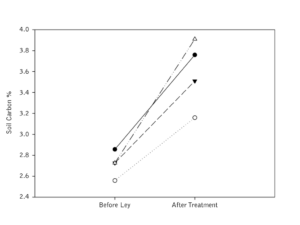
Soil Phosphorus
We choose many of our fields to receive ley rotations because they have high nutrient levels, particularly phosphorus, due to historic practices that involved a more conventional cattle operation with heavy set stocking and feeding of outside grain rations. Our hypothesis is that the crop rotations, particularly grains, can help pull phosphorus from the soil due to their high phosphorus requirements. Our hope is that the ley rotation system can act as a mitigation tool to moderate these high phosphorus loads and help prevent nutrient run-off into area streams.
Preliminary data in our first year (see Figure 4) shows that this strategy may hold promise. Most of the leys for which we had before-and-after soil data showed large drops in phosphorus concentration in the soil. One ley (open circles) did show a modest increase in phosphorus, but this ley (showing already acceptable P levels) had received intensive pastured chicken impact just before the ground was opened. The incorporation of the phosphorus-laden chicken manure into the soil likely contributed to the observed increase.
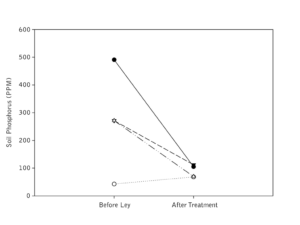
As with the previous graph, the ley represented by the open triangle had gone through a full rotation of grains/vegetables and was back in its second year of pasture. All others were measured just after completing the grain phase.
Soil Microbiology
In order to complete the DNA barcoding and functional microbial biodiversity analysis, we will need all the samples from both years of the study. However, DNA has been successfully extracted from the 2024 soil samples and is currently being stored in a -80C laboratory freezer. All extractions were checked with a Thermo Scientific Nanodrop One Spectrophotometer for extraction success. All samples showed good nucleic acid volume and low contamination, with the exception of one sample that had a low 260nm/230nm ratio, indicating possible contamination with extraction salts. We will perform an ethanol extraction on that sample to purify the DNA for sequencing.
A broad measure of microbial activity from our soil health testing, the Solvita CO2 Burst Test, suggests promising differences in the soil microbiology between the ley rotation plots and our perennial pastures (see Figure 5). Based on our preliminary data, the ley rotation plots had a higher average CO2 burst response (106.97 ppm) compared to the average for our perennial pastures (70.20 ppm).
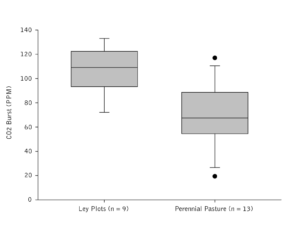
Forage Nutrition
All forage data is currently based on a small sample size (n = 4) of ley rotation pastures, due to the nature of the rotation schedule and some sampling errors. The data provide some indication of potential trends, but no conclusions should be drawn until we have a larger sample size at the conclusion of the pilot study. However, the current data suggest that the ley rotation pasture might be higher on average in moisture content, crude protein, energy content (TDN), and calcium; and lower on average in indigestible fiber content (ADF), than the perennial pastures (see Figure 6 for an example).
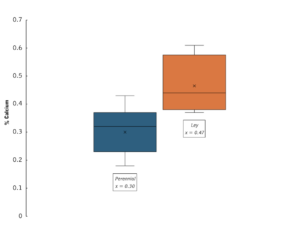
One key challenge we encountered was working in a complex environment with many projects and events occurring simultaneously throughout the landscape, handled by multiple teams, which can cause communication mishaps. Specifically, several of our experimental plots were mowed before spring forage testing took place, reducing our overall forage testing sample size. We should still be able to manage a sufficient sample size, but this spurred us to continue working on our methods of organizational communication around projects and experiments on the landscape.
We appear to be on track to answer the questions we set out to study during the grant period; however, we are already applying for grants to extend and expand the study (currently pending). We feel the current methodology and the conclusions we can draw from the study will be greatly strengthened by increased sample size, the ability to follow the same plot through all phases of the rotation (see Figure 1), and off-farm replication and study of this particular ley system. We also think the research can be strengthened and interpretation challenges addressed if we were able to add additional protocols, such as greenhouse gas flux monitoring and monitoring of the biomass production, both for crops and pasture. For instance, if the leys are sequestering more carbon in the surface soil, what if the increased tillage and animal impact are spurring the emissions of greater amounts of greenhouse gasses such as nitrous oxide? Without monitoring greenhouse gas emissions, we can not fully understand the potential climate impacts of our ley rotation system and how it compares to the climate performance of our perennial grassland pastures. Similarly, despite increases in forage nutrition, could this system have other impacts on the forage biomass produced?
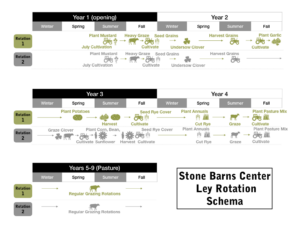
As we complete the final year of this pilot study, we will look for ways to share the results and learnings from this project with farmers in the Northeast, particularly small dairy and meat livestock farmers. In addition to publications, this may take the form of conference presentations, small-scale farmer workshops, or hosting an eventual ley-focused conference.